Now You Know Performance Analysis of Denim Garments by Bleach Wash (Part-1)
Monday, 21 January 2019
Edit
Performance Analysis of Denim Garments by Bleach Wash (Part-1)
Authors: Md. Anwarul Haque1
Ariful Hassan2
Shantonu Paul Shuvra
Md. ShagorHossain
Textile Engineering College, Begumgonj, Noakhali.
Email: haquebd2014@gmail.com1, arifulhassan034@gmail.com2
Ariful Hassan2
Shantonu Paul Shuvra
Md. ShagorHossain
Textile Engineering College, Begumgonj, Noakhali.
Email: haquebd2014@gmail.com1, arifulhassan034@gmail.com2
Abstract:
Change of appearance of denim fabric by washing was investigated using bleach treatment. The effect of various temperature and time, concentrations of bleaching powder on the degradation of denim fabrics were evaluated by means of fabric strength loss, stiffness, GSM, color fading, elongation at break, moisture absorption, change of EPI-PPI, crimp, shrinkage. It was found that bleaching powder had remarkable effect in washing on denim fabric modification. It was also observed that the degradation of denim fabric with bleach caused a serious drop in fabric strength, stiffness, color fading.
Introduction:
Denim is very strong, stiff and hard wearing woven fabric. Denim is cotton and twill weave fabric that uses colored warp and white weft yarn and used for jeans, work clothes and casual wear. Denim garment washing is known as one of the widely used finishing treatment that has vast usage in textile sectors because of creating special appearance and making fashionable and wear comfortable garments of the present day world and commonly used. Without finishing treatments, denim garment is uncomfortable to wear, due to its weaving and dyeing effects. For this it essentially needs a finishing treatment to make it softer, more supple, smooth and comfortable to wear performance. Popularity of garments washing specially on denim garments in the World market has been increasing day by day. To meet up the quick change of current demands of customers, technologists are trying to introduce new designs and fashion on denim garments by using different washing methods. The most commonly denim washing methods are bleach wash, acid wash, enzyme wash, normal wash, stone wash, etc. Among the washing methods, bleach method is widely used method in industry especially for denim washing to achieve required color shade by hypochlorite bleaching. Bleaching treatments have been successful for achieving desirable color shade and soft hand feels of cotton denim garments and are using in textile and washing industry. However, cellulase enzyme treatments have been successful at improving flexibility and soft hand feels of cotton denim garments but it degrades cellulose at the end or in the middle of the cellulose chain, yielding shorter chain cellulose polymers, and reduces its mechanical strength. So, denim washing using bleaching powder is chosen for this work.
Many researchers have investigated the washing of denim garments using various methods for the last many years but a few works has been done on washing of denim garments to develop novel design and fashion with high wear performance by bleach method. Bangladesh is a textile industry based country. Denim garments (trousers) are being produced with other garments to meet its demand in the competitive market of world and Bangladesh earned about 76% foreign currency from ready-made garments sector . In this paper, a novel and cost effective method have explored for denim washing with bleaching powder that developed new design and fashion and is produced a value-added product with high wear performance to satisfy customer’s need. In addition, the effects of washing parameters on the physical and mechanical properties of treated denim garments have investigated.
LITERATURE REVIEW
History of denim
In fashion history, jeans and denim history continues to baffle. No one truly knows the perfect answer to where jeans began. As so often happens fashions often emerge together in various parts of the world and are the result of the sudden availability of anew fabric, cloth, dye or technique. But we do know that the phrase denim jeans are thought to derive from several sources. No one is totally certain where the words come from. A majority of source books suggest that denim derives from the English translation of the South of France French phrase 'serge de Nimes'. Denim fashion history is thus associated with Serge de Nimes. When talking about denim the name Levi´ s is one of the first to be mentioned. Levi´ switch stands for Levi Strauss are normally called the forefather of jean.
When Tracing back the history of these trousers to its origins it is true that Levi Strauss played an important role concerning their development and distribution but he had also other inventive business partners Levi Strauss found out that the gold diggers´ hard work in the mines made their clothes get worn out very quickly and he produced stout working trousers out of the sail cloth he had taken with him which he called half overalls“. When he continued producing these
Trousers he used cheap cotton fabrics coming from Geneva. The name of the town of Geneva was modified into jeans” in the American slang. At the end of the sixties of the19th century he replaced the brown sail cloth by an indigo-dyed, wear resistant cotton fabric coming from France. The name of this fabric was Sergede Nimes“. Serge is the French. Expression for a combined twill and Nimes is the French town where the fabric comes from. The fabric´s name Serge de Nimes was quickly turned into Denim in American colloquial language.
By applying this indigo-dyed combined twill the first jeans out of Denim was almost born or better sewn.The application of metal rivets for jeans is due to the Polish emigrant Jacob W. Davis, also called AJacob Youphes.Although the working trousers out of Denim were stout they had a tendency to get worn-out where the pockets were. Jacob Youphes mended the trousers with a needle and thread. One day a customer inspired him to repair the torn off pockets with the help of rivets. Under the management of Levi Strauss the jeans were now produced in series. Since the trousers were so stout not only the gold diggers liked them but which is not surprising in America? The cowboys appreciated them very much, too. When the trousers were applied as working trousers for cowboys, however they got worn out at the crotch tip. This was no problem for Levi Strauss and Co. since theyreinforcedthe trousers again with metal rivets at the crossing point of the four seams at the crotch tip. About 1947 denim made a break-away from work clothing image, chiefly in the area of sportswear and rainwear and an occasional appearance in high fashion collections as a “different-looking" evening dress. In 1970 American youth adopted denim as their favorite fabric. Part of a "back to nature" movement that emphasized ecology and the natural denim being a fabric created from a natural fiber was a primary factor. Since 1960the jeans business has undergone an explosive transformation, from a source of tough, cheap clothing for cowboys, blue-collar workers and penniless youth into a fashion-conscious market for a widening mass of people of almost all ages.
Types of Denim
While the original denim was a 100% cotton serge material, we can now get it in a variety of materials, including blends that give you the same wonderful look of 100% cotton denim with some great additional features. Denim’s unique look comes from the rich indigo blue in one shade or another woven together with white threads to give the “depth” that people associate with denim. Today, some denims no longer have indigo, but other colors with the white opposing threads, producing denims in a rainbow of shades.
Types of Denim are given below:
1. Dry Denim
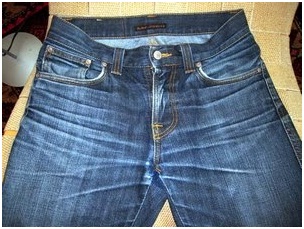 |
| Dry Denim |
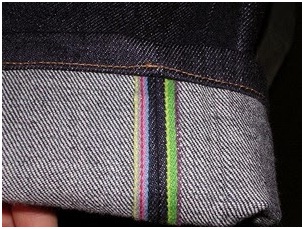 |
| Selvage Denim |
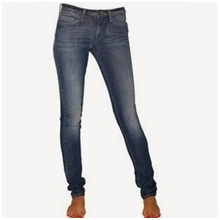 |
| Stretch Denim |
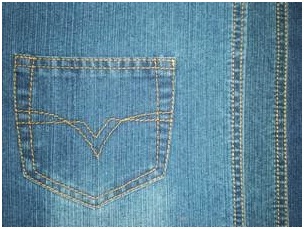 |
| Poly Denim |
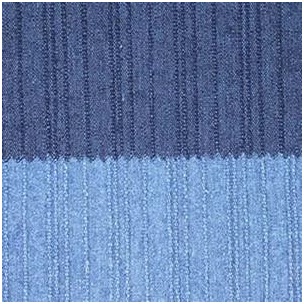 |
| Ramie Cotton Denim |
Flow Chart of Denim Production:
Spinning
↓
Bale Warping
↓
Rope Dyeing
↓
Long Chain Beaming
↓
Sizing
↓
Weaving
↓
Finishing
↓
Inspection & Folding
↓
Packing
↓
Dispatch
Denim Products
Clothing:
- Boots and athletic shoes
- Capri pants
- Dresses
- Hats
- Jackets
- Jeans
- Overalls (dungarees)
- Shirts
- Shorts, including Daisy Dukes and cut-offs
- Skirts
- Sneakers (Keds, Converse Chuck)
- Suits
- Swimsuits
- Belts
- Handbags (purses)
- Tote bags
- Bean bag chairs
- Lampshades
- Upholstery
Between 1973 and 1975 Volkswagen produced the Jeans Beetle, which had all-denim trim. They also repeated this concept in some later models. AMC offered a Levi's trim package for its Gremlin and Pacermodels,which actually spun nylon was made to imitate denim. Jeep has also offered Levi's trim packages.